Are you ready to transform simple ingredients into something truly delightful? Making your own low fat cottage cheese at home isn’t just easier than you think—it’s healthier, more budget-friendly, and endlessly versatile. Whether you’re looking for a protein-packed snack, a creamy addition to your favorite salad, or a guilt-free indulgence on toast, this recipe is your answer. Plus, with just a handful of ingredients and a little time, you’ll enjoy the satisfaction of crafting something wholesome and delicious from scratch. Let’s dive in and discover how this low fat cottage cheese recipe can become a staple in your kitchen!
Table of Contents
Recipe Card

Recipe name: Low Fat Cottage Cheese
Description: Discover how easy it is to make low fat cottage cheese at home with this simple, wholesome recipe. Perfect for those seeking a healthy, protein-rich addition to their meals, this homemade cottage cheese is fresher, creamier, and more customizable than any store-bought version. Whether enjoyed on its own, mixed into recipes, or as a topping, it’s the ultimate kitchen staple.
- Prep Time: 10 minutes
- Cook Time: 15 minutes
- Total Time: 25 minutes
- Servings: 4
- Calories: 80 per serving
Ingredients
- 4 cups (1 liter) low-fat milk
- 2 tablespoons vinegar or lemon juice (for curdling)
- A pinch of salt (optional, to taste)
- Fresh herbs or fruits (optional, for serving)
Instructions
- Heat the Milk:
In a large pot, gently heat the low-fat milk over medium heat until it reaches about 180°F (just before boiling). Stir occasionally to prevent scorching. - Curdle the Milk:
Remove the pot from heat and slowly stir in vinegar or lemon juice, a tablespoon at a time. The milk will begin to separate into curds and whey within a few minutes. - Strain the Curds:
Line a colander with a clean cheesecloth and place it over a large bowl. Pour the mixture into the cheesecloth to separate the curds from the whey. - Rinse and Squeeze:
Rinse the curds under cold running water to remove any acidic taste, then gather the cheesecloth and gently squeeze out excess liquid. - Season and Serve:
Transfer the cottage cheese to a bowl and season with a pinch of salt if desired. Add fresh herbs, fruits, or spices for extra flavor. Serve immediately or store for later.
Notes
- Use organic low-fat milk for the best flavor and texture.
- Don’t discard the whey—it’s packed with nutrients and can be used in smoothies or baking.
- For creamier cottage cheese, stir in a tablespoon of low-fat yogurt after straining.
Nutrition Information (Per Serving)
- Calories: 80
- Protein: 8g
- Fat: 2g
- Carbohydrates: 3g
- Sodium: 80mg
Why You’ll Love This Recipe
If you’ve ever wondered how to make low fat cottage cheese at home, this recipe is about to become your new favorite. Here’s why it’s a must-try:
- Healthy and Wholesome: Packed with protein and low in fat, this cottage cheese is perfect for anyone looking to maintain a balanced diet without sacrificing flavor. It’s a great addition to your meal prep routine!
- Customizable to Your Taste: Unlike store-bought versions, homemade cottage cheese gives you full control over flavor and texture. Prefer it creamier? Add a touch of yogurt. Love bold flavors? Stir in fresh herbs or spices.
- Budget-Friendly: Making your own cottage cheese is surprisingly cost-effective. With just a few simple ingredients—most of which you likely already have—you can create a versatile and delicious staple.
- Easy to Make: No special equipment or advanced skills are required. Whether you’re a seasoned cook or a beginner, this recipe is approachable and foolproof.
- Versatile Uses: Enjoy it as a snack, a topping for toast, or even as an ingredient in your favorite recipes, like lasagnas or dips. The possibilities are endless!
How to Make Low Fat Cottage Cheese (Step-by-Step)
Making low fat cottage cheese at home is a simple and rewarding process. Follow these steps, and you’ll have a fresh, healthy batch in no time!
Step 1: Gather Your Ingredients and Tools
Start with 4 cups of low-fat milk, 2 tablespoons of vinegar or lemon juice, and a pinch of salt (optional). You’ll also need a large pot, a thermometer (optional but helpful), a colander, and a cheesecloth or clean kitchen towel.
Helpful Hint: For the creamiest and most flavorful results, choose fresh, good-quality milk as your base.
Step 2: Heat the Milk
Pour the milk into a wide saucepan and gently heat it over medium flame. Stir occasionally to ensure it doesn’t stick to the bottom of the pan. Heat until it reaches about 180°F or just begins to simmer.
Why this matters: Properly heating the milk is essential for achieving the right curds for cottage cheese.

Step 3: Add the Acid
Once the milk reaches the desired temperature, carefully take the saucepan off the heat. Gradually stir in the vinegar or lemon juice, one tablespoon at a time. Watch as the milk separates into curds (solid bits) and whey (liquid). This process should take just a few minutes.
Quick Tip: If the curds don’t form right away, add another tablespoon of vinegar or lemon juice and let it sit for a few more minutes.
Step 4: Strain the Curds
Place a colander over a large bowl and line it with a cheesecloth. Carefully pour the curdled mixture into the colander, allowing the whey to drain into the bowl below. Let it sit for 5-10 minutes.
Step 5: Rinse and Drain
Gently rinse the curds under cold running water to remove any acidic taste. Then gather the cheesecloth and gently squeeze out the excess liquid, being careful not to press too hard.
Step 6: Season and Enjoy
Transfer the curds to a mixing bowl and season with a pinch of salt if desired. You can also mix in fresh herbs, cracked pepper, or a touch of honey for added flavor. Your cottage cheese is now ready to enjoy!
Storage Tip: Store your homemade cottage cheese in an airtight container in the refrigerator for up to 5 days.
Key Ingredients and Substitutions
Understanding the ingredients is essential for crafting the perfect low fat cottage cheese. Here’s a breakdown of the key components and some smart substitutions to suit your dietary needs and preferences.
Key Ingredients
- Low-Fat Milk
This is the base of your cottage cheese. Opt for fresh, pasteurized milk for the best results. Low-fat milk strikes the perfect balance between creamy texture and reduced calories, making it ideal for this recipe.
Substitution: For a dairy-free option, try unsweetened almond milk or soy milk, though the texture and flavor may differ slightly. Ensure the alternative milk is not flavored or fortified with added ingredients. - Acid (Vinegar or Lemon Juice)
The acid is what helps the milk curdle and separate into curds and whey. Both white vinegar and fresh lemon juice work beautifully in this recipe.
Substitution: Apple cider vinegar can be used as an alternative if you prefer a slightly milder tang. - Salt (Optional)
Adding a pinch of salt enhances the flavor of the cottage cheese. This step is entirely optional and can be tailored to suit your personal taste.
Substitution: If you’re watching your sodium intake, skip the salt or use a salt substitute. - Fresh Herbs or Spices (Optional)
To add personality to your cottage cheese, consider mixing in chopped parsley, dill, chives, or even a sprinkle of smoked paprika for an extra kick.
Substitution: Sweet options like a drizzle of honey or a handful of fresh fruit also pair well for a different flavor profile.
Why These Ingredients Work
- Low-fat milk provides the perfect consistency and nutritional benefits without compromising on taste.
- Acid ensures efficient curdling, creating the light and fluffy texture characteristic of cottage cheese.
- Optional add-ins allow endless customization, letting you tailor the flavor to your liking.
Tips for Choosing Substitutes
- Ensure your alternative milk contains a similar fat content to achieve a comparable texture.
- If you’re using vinegar, white vinegar is ideal for a neutral taste, while lemon juice offers a brighter, tangy flavor.
- When adding herbs or spices, mix them in after the curds have been strained for the freshest taste.
Expert Tips for Success
Making low fat cottage cheese at home is simple, but a few insider tips can take your results from good to exceptional. These practical suggestions ensure the process is smooth and your cheese turns out perfectly every time.
1. Choose the Right Milk
For the best results, use fresh, pasteurized low-fat milk. Avoid ultra-pasteurized milk, as it can interfere with the curdling process and yield disappointing results. If you’re experimenting with dairy alternatives, ensure they’re unsweetened and free of additives.
2. Heat Slowly and Evenly
When heating the milk, take your time and maintain medium heat. Stir occasionally to prevent scorching, and use a thermometer to ensure you don’t exceed 180°F. Precision here makes all the difference in achieving soft, tender curds.
3. Add Acid Gradually
Incorporate the vinegar or lemon juice slowly, one tablespoon at a time, and stir gently. Adding it too quickly can lead to uneven curdling. If curds don’t form immediately, let the mixture sit for a few minutes before adding more acid.
4. Don’t Over-Squeeze
When straining and squeezing the curds, handle them gently. Removing too much whey can make your cottage cheese dry and crumbly. Aim for a balance that retains some moisture while removing excess liquid.
5. Rinse for a Neutral Flavor
If you notice a tangy or acidic aftertaste, give the curds a quick rinse under cold water. This step neutralizes any leftover acid and ensures a clean, mild flavor.
6. Customize After Straining
Mix in herbs, spices, or sweeteners after the curds have been strained. This allows you to adjust flavors to your liking without impacting the cheese’s texture.
7. Save the Whey
Don’t throw away the whey—it’s a nutritional powerhouse! Use it in smoothies, soups, or baking recipes to reduce waste and add a protein boost to other dishes.
8. Store Properly
Homemade cottage cheese should be stored in an airtight container in the fridge and consumed within 4-5 days for optimal freshness. If you want to extend its shelf life, consider freezing it, though the texture may slightly change.
9. Experiment with Add-Ins
For savory options, try mixing in garlic powder, paprika, or finely chopped chives. If you prefer something sweet, add fresh berries, a drizzle of honey, or a pinch of cinnamon.
10. Practice Makes Perfect
Don’t be discouraged if your first batch isn’t perfect. Each time you make cottage cheese, you’ll learn what works best for your equipment and preferences. With practice, you’ll be crafting flawless batches in no time!
Variations and Customizations
One of the best things about homemade low fat cottage cheese is its versatility. You can easily tweak the recipe to suit your taste, dietary preferences, or creative culinary ideas. Here are some fun and flavorful variations to try!
1. Herb-Infused Cottage Cheese
Add a burst of freshness with finely chopped herbs like dill, parsley, chives, or basil. Stir them in after straining the curds for a vibrant, savory twist. This version pairs beautifully with crackers, salads, or as a spread.
2. Sweet Cottage Cheese
For a sweeter option, mix in a drizzle of honey or maple syrup and top with fresh fruit like berries, sliced peaches, or a sprinkle of cinnamon. It’s a delightful breakfast or snack that feels indulgent but stays healthy.
3. Spicy Kick
Give your cottage cheese a little heat by adding a pinch of chili flakes, paprika, or freshly cracked black pepper. This variation is perfect for stuffing into peppers or spreading on toast with avocado.
4. Creamier Texture
If you prefer creamier cottage cheese, stir in a tablespoon or two of low-fat Greek yogurt or a splash of milk after straining. This addition enhances the richness without adding significant calories.
5. Vegan-Friendly Option
For a dairy-free version, use unsweetened almond milk or soy milk and curdle it with lemon juice or apple cider vinegar. While the texture may differ slightly, it’s a great alternative for those avoiding dairy.
6. Protein Boost
Amp up the protein content by blending in a scoop of unflavored protein powder after straining. This is ideal for fitness enthusiasts looking for a high-protein, low-fat snack.
7. Flavored Cottage Cheese Spreads
Transform your cottage cheese into a gourmet spread by mixing in ingredients like sun-dried tomatoes, olives, or caramelized onions. Serve it as an appetizer with bread or crackers.
8. International Twists
- Italian: Add garlic, oregano, and a sprinkle of Parmesan cheese for an Italian-inspired version.
- Mexican: Mix in lime juice, cilantro, and a pinch of cumin for a zesty take.
- Indian: Blend in turmeric, garam masala, and a dash of ginger for a warm, aromatic flavor profile.
9. Low-Sodium Option
Skip the salt entirely and focus on flavor enhancers like herbs, spices, or a dash of citrus juice. This works wonderfully for individuals who are mindful of their sodium consumption.
10. Meal Prep Inspiration
Prepare a few variations in advance to keep your meals exciting throughout the week. Store each flavor in a separate container and label them for quick grab-and-go options.
Storage and Reheating Instructions
Keep your homemade low fat cottage cheese fresh and delicious with these simple tips:
Storage Tips
- Refrigerate Promptly: Store in an airtight container at or below 40°F (4°C).
- Consume Quickly: Enjoy within 4-5 days for the best taste and quality.
- Freezing: Freeze in a sealed container for up to 2 months, but note that the texture may change. Thaw in the fridge overnight and stir well before use.
Reheating Tips
- For Recipes: Add directly to hot dishes like lasagna for even heating.
- On Its Own: Warm gently on low heat, stirring to avoid curdling.
Preventing Spoilage
- Signs to Watch For: Discard if you notice a sour smell, discoloration, or odd texture.
- Seal It Tight: Always reseal after use to keep it fresh longer.
Serving Suggestions
Homemade low fat cottage cheese is versatile and delicious. Here are some quick ideas:
Simple and Classic
- Spread on toast with honey or pair with fresh fruits.
- Serve as a side with a sprinkle of salt and olive oil.
Savory Options
- Top salads or use in dips with herbs and garlic.
- Stuff into bell peppers or use as a creamy pasta filling.
Sweet Treats
- Layer in parfaits or blend into smoothies.
- Top pancakes or waffles with fruit and a drizzle of honey.

Frequently Asked Questions (FAQs)
Here are some common questions about making and enjoying homemade low fat cottage cheese. These tips will help you perfect the process and get the most out of your recipe!
Can I use whole milk instead of low-fat milk?
Yes, you can use whole milk if you prefer a creamier texture. However, keep in mind that it will increase the fat content.
What should I do if my milk doesn’t curdle?
If the curds don’t form after adding the acid, try reheating the milk slightly and adding another tablespoon of vinegar or lemon juice. Let it sit for a few more minutes.
Can I use plant-based milk?
Yes, unsweetened almond milk or soy milk can work, but the texture and flavor will be different. Use lemon juice or apple cider vinegar as the curdling agent for the best results.
Related Recipes
If you enjoyed making low fat cottage cheese, you’ll love exploring these other easy and healthy homemade recipes. Each one offers a fresh twist on classic dairy or protein-rich options, perfect for adding variety to your kitchen creations!
- Homemade Greek Yogurt: Discover how to make creamy, tangy Greek yogurt with just two ingredients. Perfect as a base for smoothies, dips, or a healthy breakfast topped with granola and fruit.
- Ricotta Cheese from Scratch: Try your hand at another homemade cheese! This soft, fluffy ricotta is ideal for lasagnas, desserts, or spreading on toast with a drizzle of honey.
- Protein-Packed Smoothie Bowls: Use your cottage cheese in a vibrant smoothie bowl. Blend it with fruits, almond milk, and a scoop of protein powder for a nutritious, filling breakfast or snack.
Conclusion
Homemade low fat cottage cheese is more than just a recipe—it’s a testament to how simple, wholesome ingredients can transform into something truly delightful. By making it yourself, you gain control over the flavors, textures, and quality, ensuring a product that’s both healthier and tastier than store-bought versions.
Whether you’re spreading it on toast, mixing it into savory dishes, or enjoying it as a light snack, this versatile cheese fits seamlessly into any meal. Plus, the satisfaction of creating something fresh from scratch is unmatched.
So, why not give it a try? With its endless customizations, this recipe allows you to get creative and make it your own. Share your experience, experiment with flavors, and enjoy the journey of cooking with confidence. Once you’ve tasted the difference, you’ll never look back. Happy cooking!

